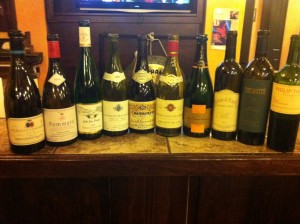We were excited when we were approached by our local vendor to host a casual tasting with Cleo Pahlmeyer last Monday. We’ve enjoyed some fine, mid-90s Red Blends and Merlot from this family-owned winery so we were interested in visiting their current releases. As this is Graileys, naturally, there were already a few bottles on the table when Cleo walked in the door around 5:30pm on a Monday.
In my glass, a 2002 Vincent Dauvissat Chablis Le Clos which was a muted on the nose. Some subtle hints of lime blossom, chalky minerality and citrus were barely peeking from the glass but not much else. The palate was even more reticent with very steely texture and a laser-like acidity that kept my palate salivating but it seemed disjointed, lacking in mid-palate and flavor depth and its overall structure overwhelmed by intense acidity. I think this wine is just in a quirky spot right now and will undoubtedly benefit from additional time in bottle. For now, I am on defense with this wine.
Simon next poured a 1990 Ramonet Chassagne-Montrachet Morgeots which was compelling straight out of the bottle. Intense bouquet of corn kernel, buttered toast, smoky floral, poached pears, apples, and roasted hazelnuts were balanced by a palate that was fleshy, rich and broad. Impressive acidity provided a nice lift to the palate. Persistent lively finish. Fully mature and I think in a fantastic spot right now.
Well, as Cleo was in the house, we officially started the Pahlmeyer part of the afternoon.
First on the line-up was the 2010 Pahlmeyer Sonoma Coast Chardonnay mostly from Wayfarer Farm Vineyard, the family’s estate vineyards located in the ‘true Sonoma Coast’ in the newly-created, Fort-Ross Seaview AVA. This had opulence and riper fruit intensity on the nose. Toasty oak, vanilla with golden delicious apples, peach, apricot, tangerine emanated from the glass. In the mouth, this showed a round, lush texture with plenty of ripe stone fruits. Full bodied with a vibrant acidity to keep the wine’s rich structure in check. A percentage of the fruit was sourced from Russian River Valley’s Ritchie Vineyard.
I poured the 2010 Pahlmeyer Sonoma Coast Pinot Noir, a blend of Wayfarer and Hallberg Vineyards fruits, which was expressive and persistent with black cherries, baking spices, wild berry jam, and plum. Seamless and velvety on the palate. There was a definition here that I enjoyed. Juicy and vibrant Pinot Noir that is begging to be enjoyed now for its succulent fruit and sexy texture.
The 2009 Pahlmeyer Napa Valley Merlot was tasted next. This bottling is complemented by an addition of 11% Cabernet Sauvignon to the blend. Ripe and aromatic on the nose with tons of plums, blackcurrant, black raspberries, spice, and fig and sweet oak nuance. Full and richly-fruited on the palate with supple tannins.
The 2009 Pahlmeyer Napa Valley Proprietary Red Blend was poured next exhibiting bold cassis, blackcurrant, black cherries and mocha aromatics. In the mouth this was fleshy and broad in structure packed with ripe dark fruits and a healthy dose of toasty cedar.
As I was re-tasting my Pahlmeyer Pinot Noir, I was poured a 1969 Remoissenet Volnay Clos des Chenes whose iron, mineral, dusty cherry, dried bay leaf and undergrowth bouquet provided a stark contrast to the otherwise plush, fruit-driven style of the former. This Remoissenet’s lively freshness at this stage of bottle age is just intriguing.
A taste of 1990 Veuve Clicquot Cuvee Privee was poured in my glass next. This had rich and intoxicating aromatics of toast, bread dough, quince, Asian pear and almonds which led to a palate that was full-bodied yet elegant with mousse that was creamy and refined. There was a beautiful citrusy acidity and a streak of minerality in the palate that kept the wine vigorous. Enviably long finish. Very youthful right now.
I next tasted a 1996 Hudelot-Noellat Romanee-St-Vivant. Complex and mature bouquet reminiscent of cured meat, iron, clove, damp forest floor, and wild mushroom with a core of candied, rich red fruits emanating from the glass. In the mouth, this was medium-bodied with silky, rich texture and deep, sweet flavors . Persistent finish. This was a beautiful bottle.
A sip of the 1999 Hudelot Noellat Romanee-St-Vivant immediately followed. This was more robust and meatier relative to the 1996. Initially reticent but with an hour of sitting in the glass, this wine blossomed with savory notes of black truffle, earth and tea leaves intermingling with plums, black cherries and black raspberries. Next to the 1996, this was more density and structure. Drinking now but clearly has the structure and balance to improve with another decade of cellaring.
As I was contemplating my preference of these duo of Romanee-St-Vivant, I caught Simon motioning me to the bar area. He handed me a glass of red and asked me to nose it. I said, “pyrazines, green peppercorn, jalapeno, green bell pepper” and I liked it. This turned out to be a 1999 Philip Togni Cabernet Sauvignon. This proved to be a very contentious bottle with some people declaring this bottle “absolutely corked” and “all wet cardboard with a twist of jalapeno.” I was on the yes-herbaceous and green- but-not-corked camp. I’ve always been a fan of Togni’s Bordeaux-like restrain and aging potential. There was no way this wine was corked given that even with the upfront cedar and herbaceous character, there was this big, rich core of plum, blackcurrant and black cherries in the palate. Someone suggested we send this to a lab to get a definitive answer. Well, that won’t be a first. Only at Graileys, folks….


